
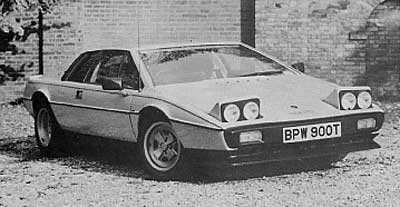
Lotus Esprit S1
THE Lotus Esprit, an out-and-out two seater with mid-placed engine, was first introduced in 1975. Its stunning looks are courtesy of Giugiaro and based on a styling exercise at the Turin Show in 1972 — so the design has worn well. A drag co-efficient of only 036 is claimed for the series 2. The body itself is glass fibre and made at Hethel and overall the car weighs just over the ton. Beneath the body a familiar Lotus steel backbone chassis is found. At the front end unequal length double wishbone independent suspension uses Opel Ascona parts linked to a Lotus rack for the steering. At the rear Lotus use trailing arms with the drive-shaft doubling as an upper link. Coil spring/damper units are used throughout. Brakes are by disc — inboard at the rear. The Lotus 2 litre engine has twin overhead camshafts operated by silent toothed belt and four valves per cylinder. It runs on a 95 to 1 compression ratio to produce a highly respectable 160 bhp at 6200 rpm. The unit is inclined 45 degrees to the nearside of the car and is contained under a metal cover in the luggage area which is separated from the passengers by a bulkhead. Colin Chapman clearly took his shopping basket around the European supermarket for, mated to the engine, we find a Citroen SM gearbox.
When the car was first reviewed tribute was rightly paid to the Esprit’s road behaviour but criticised on engine noise, visibility, poor ventilation and some minor points too. The S2, launched last autumn, is the answer to these criticisms but in this it has only partly succeeded.
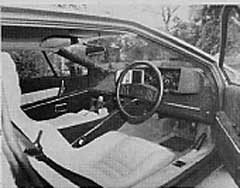
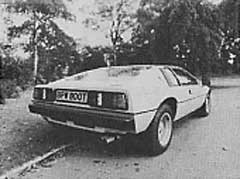
One thing that has not changed is poor visibility as this is inherent in the design. Mid-engines are great in two seater sports exotica provided one accepts that the layout, while superb for road behaviour, has its disadvan-tages in poor luggage accommodation and visibility. Three quarter vision is traditionally bad and the Esprit is no exception — the windows behind the doors are of little help — so the electrically adjustable door mirrors are an essential aid. Forward vision is not so good either—even a six-footer can only see the lip of the sharply dipping bonnet at the base of the windscreen. The wings are out of view and the fact that the car is six foot and one inch wide is brought home when negotiating London streets and traffic jams. This makes it wider than an Aston Martin — itself a wide car — but it is made worse by the low seating position. After a while; of course, one soon learns to judge gaps but even so it would be preferable when traveling quickly on country roads, say, to be able to see clearly the car’s extremities. In these conditions the Esprit’s advantages in speed and road holding may be lost to a car of more manageable proportions. So too in city traffic the very lowness of the vehicle can present difficulties when emerging from junctions where there are parked vehicles, while filtering maneuvers need a van driver’s approach. None of these things are so serious as to mar the car but they do require the driver’s attention.
On the open road, however, the Esprit is pure joy, a driver’s delight. Steering is by rack and pinion and unassisted in view of the lightly loaded front end. It has the right weight and feel on the road, but some tendency to wander is more a feature of the 205/60 section Dunlop tyres nibbling at surface irregularities. At parking speeds the steering is just a shade too heavy. Ride is surprisingly good for a “driving machine” with only very bad surfaces intruding. Suspension movement is supple but well controlled, so that mid corner bumps do not unsettle the car. It would be very strange indeed if a Lotus were to be anything but exemplary in its handling — in this the Esprit does not disappoint. At the limit the car under-steers but backing-off the throttle converts this to easily controlled oversteer. To most people such attitudes on the open road will be purely academic even at the high speeds attainable. In these situations the car just steers. No car that goes as well as this can afford to be without good brakes. Again Lotus leaves nothing to chance — there are 97in discs at the front and 106in discs at the rear with servo assistance. The brakes are immensely powerful, with the rears locking first, and the overall pressures needed are light.
The five speed gearbox has top positioned on a dog-leg right and it is long-legged enough to be marked o/d on the wooden gearlever knob. The action is satisfying and quick at speed but a little less certain at lower speed, a blip on the throttle helps here. This whole process is made more satisfying by the padded backbone which locates the driver in addition to the seat and produces a relationship between gearlever and steering wheel and pedals rarely found outside racing cars. The seats, in optional ribbed cream leather were remarkably comfortable even though their rake is not adjustable, and there is sufficient fore and aft movement to satisfy a six foot driver. Entry into the seat is over a wide sill but door openings do not suit the long-legged.
Overall engine noise is very well suppressed in view of its proximity to the driver’s ear and it is the exhaust note which dominates. Person-ally I did not find noise levels excessive for this type of car, especially as the sound is eager and pleasant. It is true, however, that speech is made more difficult as the speed is increased. There are some disturbing reflections caused by the glass panel behind the driving compartment in both the windscreen and instrument glasses. These instruments live in a curved binnacle with the two major instruments directly ahead and minor instruments either side. Switches have fibre-optic illumination at night except for the heat/vent sliders which additionally are awkward to find behind the steering wheel and difficult to operate. Electric window lift and choke controls are found on the forward edge of the padded backbone behind the gearlever. The handbrake is efficient but poorly sited too far forward on the right-hand sill. There are comfortable inertia reel seat belts and a lidded but unlockable fascia glove box and a container between the seat backs suffices for internal stowage.
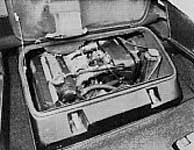
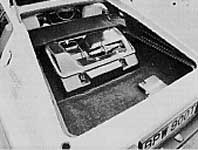
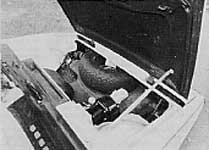
The front compartment contains the emergency spare wheel and tyre (these are of different sizes front to back on the Esprit) and space only for small items. Wiring and hydraulic pipes look a bit exposed. The release for this compartment is a bar under the dashboard on the driver’s side but it is apt to hide itself away completely when released. That for the rear compartment is a small T-handle in the offside door shut. This opens the large strut-assisted tailgate that extends back to the side window line. A tonneau protects luggage from prying eyes, and the engine cover unclips for access which is not a strong point. Fuel filler caps for the twin tank are not lockable — the tanks are connected by a balance pipe. The Esprit has separate sidelamps and the head-lamps will raise and flash in one operation using the right-hand stalk. Strident horns are fitted; a single wiper lacks an intermittent facility but has two speeds, the faster being usefully so. This large wiper leaves an unwiped area to the right which enlarges the blind spot created by the pillar, and the parallel link bar flew apart but was quickly put right by Tim and Zoe Handles at Stoke. The engine is a little difficult to ‘catch” but warms up quickly — the choke appeared not to be connected on the test car. Heating is adequate but ventilation is still not over-good even with the noisy fan operating on second speed. Two ashtrays are provided on the sills but are poorly positioned and the lack of a cigarette lighter is surprising in this class of car, as is the lack of warning lamps or even reflectors for the large doors. I personally disliked the dark brown cropped velour, which covers doors and the large expanses in front of driver and passenger. It does not in my opinion fit in with the quality image Lotus is presumably seeking with this car but the leather seats break the monotony.
The top speed of this stunning looking motor car is a claimed 138 which seems entirely possible on the gearing and peak power is at 6200rpm. A 0-60 time of around 8 secs is respectable by any standards and the Esprit goes on to 100mph in a shade under 23 sec. Therefore our overall fuel consumption figure of 21.36 mpg which took in town driving, cross country, motorway and speed testing is highly creditable and demonstrates that super cars need not be environmentally embarrassing. At just under £15,000 as tested comparisons are difficult – there is really nothing like it at the price. If only Father Christmas would leave one in my stocking.
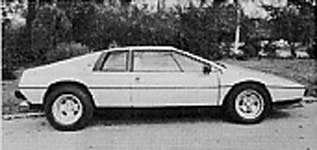
|
|